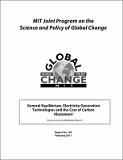| dc.contributor.author | Lanz, Bruno, 1980- | |
| dc.contributor.author | Rausch, Sebastian | |
| dc.date.accessioned | 2011-03-23T18:58:15Z | |
| dc.date.available | 2011-03-23T18:58:15Z | |
| dc.date.issued | 2011-02 | |
| dc.identifier.uri | http://globalchange.mit.edu/pubs/abstract.php?publication_id=2140 | |
| dc.identifier.uri | http://hdl.handle.net/1721.1/61772 | |
| dc.description | Abstract and PDF report are also available on the MIT Joint Program on the Science and Policy of Global Change website (http://globalchange.mit.edu/) | en_US |
| dc.description.abstract | Electricity generation is a major contributor to carbon dioxide emissions, and a key determinant of abatement costs. Ex-ante assessments of carbon policies mainly rely on either of two modeling paradigms: (i) partial equilibrium models of the electricity sector that use bottom-up engineering data on generation technology costs, and (ii) multi-sector general equilibrium models that represent economic activities with smooth top-down aggregate production functions. In this paper, we examine the structural assumptions of these numerical techniques using a suite of models sharing common technological features and calibrated to the same benchmark data. First, our analysis provides evidence that general equilibrium effects of an economy-wide carbon policy are of first-order importance to assess abatement potentials and price changes in the electricity sector, suggesting that the parametrization of Marshallian demand in a partial equilibrium setting is problematic. Second, we find that top-down technology representations produce fuel substitution patterns that are inconsistent with bottom-up cost data, mainly because of difficulties in capturing the temporal and discrete nature of electricity generation by means of aggregate substitution elasticities. Our analysis highlights the difficulty to parameterize numerical models used for policy projections, and suggests that the integration of a bottom-up electricity sector model into a general equilibrium framework provides an attractive structural alternative for ex-ante policy modeling. | en_US |
| dc.description.sponsorship | This study received support from the MIT Joint Program on the Science and Policy of Global Change, which is funded by a consortium of government, industry and foundation sponsors. | en_US |
| dc.language.iso | en_US | en_US |
| dc.publisher | MIT Joint Program on the Science and Policy of Global Change | en_US |
| dc.relation.ispartofseries | ;Report no. 194 | |
| dc.rights | An error occurred on the license name. | en |
| dc.rights.uri | An error occurred getting the license - uri. | en |
| dc.title | General Equilibrium, Electricity Generation Technologies and the Cost of Carbon Abatement | en_US |
| dc.type | Technical Report | en_US |
| dc.identifier.citation | Report no. 194 | en_US |
